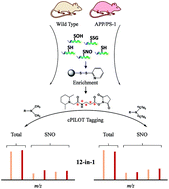High-throughput endogenous measurement of S-nitrosylation in Alzheimer's disease using oxidized cysteine-selective cPILOT†
Abstract
Reversible cysteine modifications play important physiological roles such as modulating enzymatic catalysis, maintaining redox homeostasis and conducting cellular signaling. These roles can be critical in the context of disease. Oxidative modifications such as S-nitrosylation (SNO) are signatures of neurodestruction in conditions of oxidative stress however are also indicators of neuroprotection and normal signaling in cellular environments with low concentrations of reactive oxygen and nitrogen species. SNO is a dynamic and low abundance modification and requires sensitive and selective analytical methods for its detection in biological tissues. Here we present an enhanced multiplexing strategy to study SNO in complex mixtures arising from tissues. This method, termed oxidized cysteine-selective cPILOT (OxcyscPILOT), allows simultaneous analysis of SNO-modified peptides in 12 samples. OxcyscPILOT has three primary steps: (1) blocking of free thiols by a cysteine-reactive reagent, (2) enrichment of peptides containing SNO on a solid phase resin, and (3) isotopic labeling and isobaric tagging of enriched peptides on the solid phase resin. This approach offers the advantage of allowing total protein abundance levels to be measured simultaneously with endogenous SNO levels and measurement of SNO levels across four biological replicates in a single analysis. Furthermore, the relative amount of SNO on a specific cysteine site can also be determined. A well-known model of Alzheimer's disease, the APP/PS-1 transgenic mouse model, was selected for demonstration of the method as several SNO-modified proteins have previously been reported in brain and synaptosomes from AD subjects. OxcyscPILOT analysis resulted in identification of 138 SNO-modified cysteines in brain homogenates that correspond to 135 proteins. Many of these SNO-modified proteins were only present in wild-type or AD mice, whereas 93 proteins had SNO signals in both WT and AD. Pathway analysis links SNO-modified proteins to various biological pathways especially metabolism and signal transduction, consistent with previous reports in the literature. The OxcyscPILOT strategy provides enhanced multiplexing capability to current redox proteomics methods to study oxidative modifications of cysteine.

- This article is part of the themed collections: Emerging Investigators and Alzheimer's Research Month 2016

 Please wait while we load your content...
Please wait while we load your content...